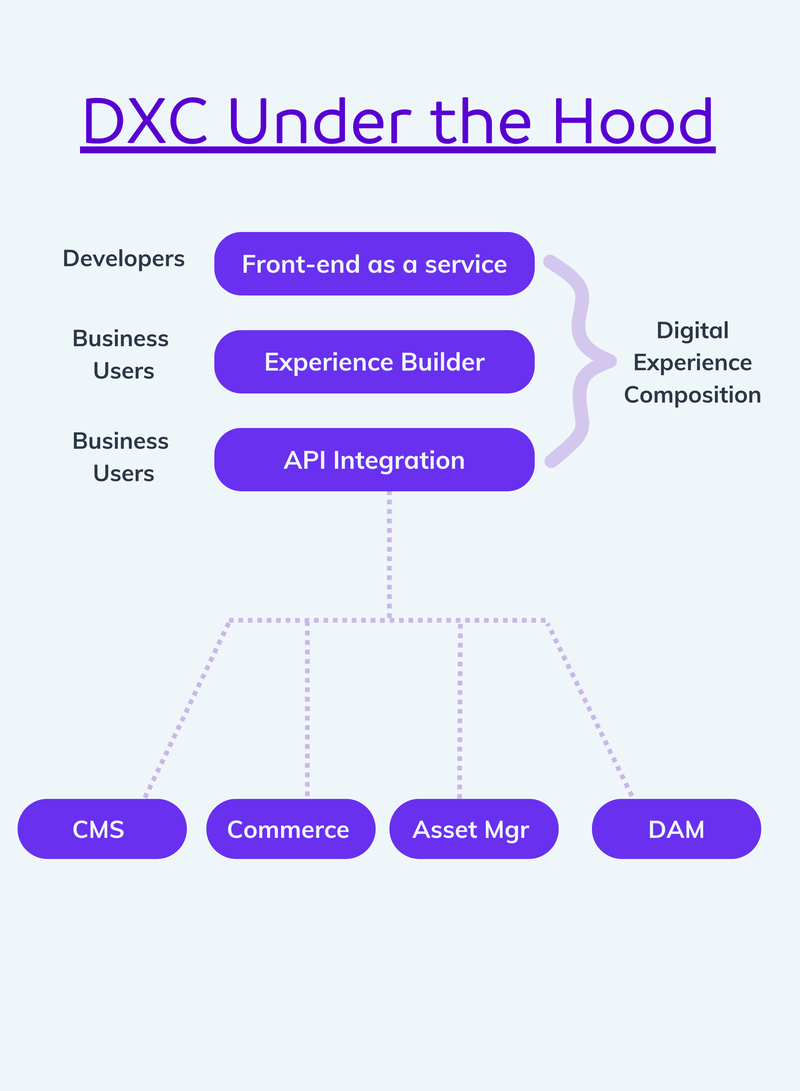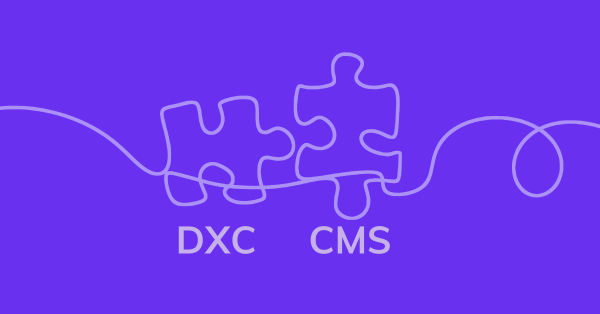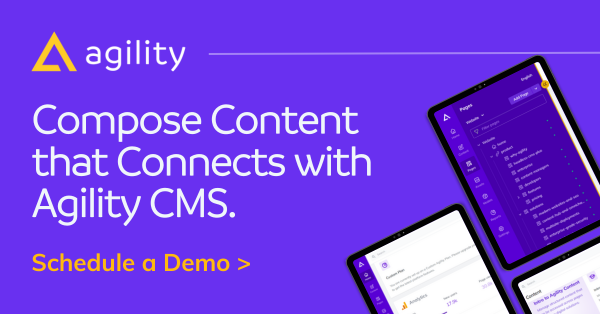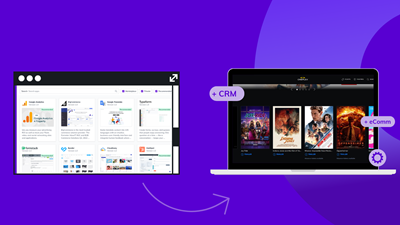What is Digital Experience Composition (DXC)?


Enterprise software is undoubtedly an exciting sector, but with that excitement comes disillusionment. Crushed expectations, hype bubbles, underperforming platforms, you name it, we’ve seen it.
Digital leaders are often bombarded with new tech terms and hyper-hyped platforms on their social media. It can take a lot of work to determine what's valuable and just hype.
Just like "digital experience platforms platforms" or "omnichannel experiences" made waves in the past, "Digital Experience Composition" (DXC) is the new hottest item in the headless community.
As such, we wanted to give you a no-frills, unbiased opinion of DXC and whether you should consider adopting it.
What is DXC?
Digital Experience Composition is the coordination of tools in a "headless" and disaggregated environment emphasizing APIs and modular composition.
According to Gartner, Digital experience composition (DXC) “is the bundle of low-code developer and no-code business user tools used to create, develop and maintain digital experiences.”
Let’s unpack this definition. Digital Experience Composition is a practice that enables the orchestration of multiple elements within your technological stack. It allows for the efficient creation and management of digital experiences without your team needing to be hyper-technical.
This means content specialists and business users can operate within the system, utilizing all available resources and reducing the dependency on developers.
DXC essentially bridges technologies within a user-friendly platform to streamline digital content creation and management.
DXC Under The Hood
Digital Experience Composition is not just a collection of tools but a well-defined methodology which leverages a specific combination of technologies to deliver a seamless user experience.
Let’s see more about that:

Frontend as a Service (FEaaS)
- Pre-built Templates and Components: FEaaS providers offer a library of pre-built templates and components businesses can use to create their frontend experiences. This can save businesses significant time and money; they don't need to build everything from scratch.
- Customization: FEaaS providers also offer high customization so businesses can tailor their frontend experiences to their needs. This includes the ability to change the look and feel of the front-end, as well as the functionality.
- Scalability: FEaaS providers are designed to be scalable, so businesses can easily add or remove users as needed. This is important for businesses growing rapidly or with seasonal traffic fluctuations.
- Managed Services: FEaaS providers typically offer managed services, which means they take care of the day-to-day maintenance and operations of the front-end. This frees up businesses to focus on other aspects of their business.
Experience Editor
- No-code Content Management: Allows content authors to edit and manage the content of a front-end experience without knowing how to code. EEs typically provide a visual interface allowing authors to change a page's content without worrying about the underlying HTML or CSS.
- User-friendliness: EEs are often used with FEaaS providers, as they can help create and manage frontend experiences more efficiently. For example, an EE can be used to add or move components, set up personalization rules, create tests, and review analytics, all while seeing exactly what the page will look like to the end user.
API Orchestration Layer
- Aggregate Data from Multiple APIs: An API orchestration layer can aggregate data from multiple APIs into a single data set. This can be useful for applications needing data from multiple sources.
- Transform Data: An API orchestration layer can transform data from one format to another. This can be useful for applications that need to use data in a different format than the format it is returned from the API.
- Route Requests: An API orchestration layer can route requests to the appropriate API. This can be useful for applications needing different APIs depending on the user's request.
- Manage Security: An API orchestration layer can be used to manage security for API requests. This can include things like authentication, authorization, and encryption.
What Does DXC Solve?
Composability doesn't come without its fair share of challenges, but if you’ve bought or used monolithic applications, you know that just because it says “all-in-one” doesn’t mean that implementation and scaling will be any easier.
Early technology adopters across industries have started migrating to composability after decades of frustration with the “all-in-one” solutions of the past. While they serviced companies well at the onset of the digital era, organizations are realizing how much more agile they need to be and how much this is hindered by the DXPs of yesteryear.
Composability gives organizations the agility to personalize their digital stack, giving them more time to focus on optimization and scaling.
While we are advocates for composability, it goes without saying that challenges arise in newly adopted principles. Integrating multiple systems can introduce vulnerability when monitoring and managing multiple microservices.
Adding an orchestration layer keeps all your data points under the same roof and gives editors and business users a visual editing tool to deliver omnichannel experiences at scale.
All in all, DXCs help address:
- Excessive Glue Code: Glue code is executable code that integrates parts of code that would otherwise be incompatible. Sometimes, connecting headless CMSs with the rest of your tooling requires ownership and maintenance, with integration code frequently being the most challenging to manage.
- Lack of Independence to Create Digital Experiences: Craft and oversee pages on your own. DXC tools present a user-friendly visual interface, empowering you to build and adjust pages quickly. No more delays or extensive waits in the engineering queue.
- Cost Overruns: We believe your website should be under your control. With DXC, your cost remains constant no matter the number of pages you create, the visitors you attract, or the customers you serve. As a business leader, you appreciate the importance of return on investment, and that's exactly what a DXC platform delivers.
| DXC | DXP | |
| Capabilities | Digital experience composition |
CMS, personalization engine, analytics tool, and DAM |
|
Purpose |
Essential for brands wanting to build their own DXP with a composable approach |
Building, managing, and delivering omnichannel digital experiences |
|
Architecture |
Composable architecture enabling flexibility and modularity |
Traditionally offered through monolithic architecture (all capabilities are part of the same product) or a product suite (capabilities offered by separate products from the same vendor, pre-integrated) |
|
Vendor Dependence |
Reduced dependence on a single vendor |
Traditionally requires dependence on a single vendor for all capabilities |
Read more: What is a Digital Experience Platform?
DXC VS DXCP
|
Feature |
Digital Experience Composition (DXC) |
Digital Experience Composition Platform (DXCP) |
|
Definition |
DXC is a method that involves using a combination of various technologies and tools to create and manage digital experiences. |
DXCP is an integrated platform that provides all the necessary tools and technologies needed for implementing DXC. |
|
Components |
DXC comprises of three core components: Frontend as a Service (FaaS), Experience Editor, and API Orchestration Layer. |
DXCP incorporates the three core components of DXC and may also include additional tools and services that are designed to support the implementation of DXC. |
|
Flexibility |
DXC, as a methodology, provides a high degree of flexibility as it allows organizations to select and integrate different tools and technologies based on their specific needs. |
Depending on the platform, DXCP may offer less flexibility as it typically comes with a predefined set of tools and technologies. However, some DXCPs may also support the integration of external tools and technologies. |
Benefits of DXC
Reduced Vendor Lock-in
Traditional bulky suites and monolithic DXPs result in vendor lock-in, pressuring businesses to remain with a single service because of migration complexities and the perceived advantage of a comprehensive solution. Old-style monoliths can't always give the best results, forcing businesses to settle for less. However, a DXC platform lets you control every part of your system fully, helping you break free from any limitations.
Faster Time to Value
By giving more control to business users, DXC lets brands and enterprises quickly get their products and services to the market, adapt to changes easily, and improve customer offerings faster. It makes it possible to start campaigns across platforms without marketers and content creators always needing a developer's help when they want to launch something new.
Composable Architecture
Composable architecture allows businesses to mix and match components to meet specific needs. If the requirements change or the business scales, it is easy to swap out one component for another or add new ones. By leveraging pre-built components, business users can focus on assembling the pieces of their toolbox to best suit their current requirements.
Drawbacks of DXC
Lack of Buy-in
Without executive support, a software project may not receive the funding, personnel, or time it requires for successful implementation and execution. Plus, if executives are not supportive, they may not encourage or mandate the use of the new software.
Potential for Added Complexity
DXCs often need to integrate with various other systems like Customer Relationship Management (CRM) systems, eCommerce platforms, Content Management Systems (CMS), and analytics tools. Managing these integrations can add complexity if your organization isn’t ready to face the music.
How Do DXC and Headless CMS Work Together?

For this, we asked Harmonie Poirier, Senior Marketing Manager at Agility CMS, to shine some light on where a headless CMS fits within all this. Here’s what she had to say:
Having worked in this industry for a couple of years, I've seen trends come and go from hybrid CMS to composable DXP and now DXC. While all these terms and trends can become arduous, it is ultimately used to distinguish vendors pushing the envelope of what is possible in digital. The good news is that while headless CMS has evolved, it remains the same by definition, being the decoupled manager and creator of content. DXC is the practice of using APIs to bring tools together in a low-code environment. It is a principle and an emerging standard that challenges the current shortcomings of the composability market. Organizations ready to leave the “all-in-one” vendors are rightfully weary of the TCO, time and team requirements to make a composable ecosystem operate. DXC is how composable vendors, such as Agility CMS, communicate best practices to customers while offering an architecture that addresses composability’s shortcomings through API-first CMS and low-code marketplace integrations.”
How Agility makes digital experience composition possible
- MACH architecture: By leveraging MACH architecture principles and industry-leading partnerships, we empower users to deliver exceptional digital experiences that drive customer engagement, foster loyalty, and keep your business ahead in today's dynamic digital landscape.
- Personalization: Agility CMS provides customers agility, personalization, omnichannel capabilities, enhanced engagement, and scalability.
- Omnichannel content delivery: As a DXCP, Agility allows clients to easily manage and distribute content across multiple channels and seamlessly integrate with other services.
- API-first approach: Enables clients to create content once and then distribute it anywhere, seamlessly integrating it with their existing technology stack for the best DXC.
- Cloud-native: Agility runs on the latest cloud infrastructure, making it easy for clients to scale their solutions as their business grows.
- Headless approach: The platform allows clients to easily separate the content from the presentation layer, giving them the freedom to deliver customized experiences across a variety of channels.
Are You Ready for DXC?
If you think you’re ready for digital experience composition, take a long hard look at your organization and ask yourself these seven questions.
- Does your marketing team function across multiple countries, markets, and channels?
- Are business users able to modify or configure the experience without developers?
- Have you assessed the extent of content complexity within your organization?
- Do developers need help with outdated tech and custom code to maintain?
- Have you evaluated the degree of content complexity in your organization?
- Are you aware of the impact of your tech stack in your bottom line?
- Do marketers’ best ideas get stuck in the dev backlog?
Embrace the Future of Content Delivery With Digital Experience Composition
Digital Experience Composition (DXC) presents a promising development in the enterprise software landscape. It offers a practical solution to managing multiple tools and platforms in your tech stack, reducing the complexity associated with headless systems and improving overall efficiency.
By providing a visual interface for content editors and business users, DXC empowers them to create omnichannel digital experiences at scale, without the added pressure on the development team.
However, it does come with its own set of challenges, such as potential complexity and the necessity of executive buy-in.
DXC also offers key benefits such as reduced vendor lock-in, faster time to value, and a composable architecture. Yet, transitioning to DXC isn't a one-size-fits-all solution and requires careful consideration of the organization's specific needs and circumstances.
Before jumping onto the DXC bandwagon, it is critical for businesses to assess their readiness by evaluating their current marketing operations, tech stack impact, and content complexity. If the majority of these factors align with the capabilities of DXC, it can prove to be a transformative step toward optimizing digital experiences.





